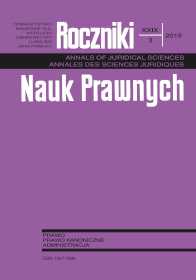Praktyka opodatkowania wyrobisk górniczych po wyroku Trybunału Konstytucyjnego z dnia 13 września 2011 roku (P 33/09)
The Practice of the Taxation of Post-Mining Pits after the Judgement of the Constitutional Court of 13 September 2011 (P 33/09)
Author(s): Paweł Smoleń, Marzena ŚwiastakSubject(s): Law, Constitution, Jurisprudence, Civil Law
Published by: Towarzystwo Naukowe KUL & Katolicki Uniwersytet Lubelski Jana Pawła II
Keywords: post-mining pits; construction features; services and facilities; property tax
Summary/Abstract: For a long time, the issue of the taxation of underground post-mining pits and their equipment with the real estate tax has been an issue that has given rise to divergent judicial decisions of tax authorities and administrative courts. Doubts arise, first and foremost, from the ambiguity of legal definitions concerning the issues mentioned above. Such a situation led directly to certain divergence among different decisions of tax authorities and administrative courts.As a result of constantly growing doubts, the Voivodship Administrative Court in Gliwice submitted a motion to the Constitutional Tribunal to examine the constitutionality of the provisions of the Local Taxes and Fees Act to the extent to which they define a building as a subject of taxation. The Constitutional Tribunal issued an interpretative judgement which is of crucial importance for the practice of the taxation of post-mining pits. First and foremost, it resolved the fundamental dilemma concerning the post-mining pit both in its physical and comprehensive sense, deciding that as such a post mining pit does not constitute the subject of taxation.The Constitutional Tribunal stated that underground post-mining pits are not construction features (services and facilities) in terms of the Construction Law, but space created as a result of mining works, and consequently the cannot be qualified as structures under the provisions of the Construction Law. Therefore, they are not subject to real estate tax either independently (as excavations in the physical sense) or together with their infrastructure (as excavations in the comprehensive sense). The situation is different in the case of infrastructure located in underground post-mining pits. Its individual elements may be classified as construction structures (construction equipment) under the Construction Law, and thus as structures under the Local Taxes and Fees Act.While the issue of exclusion of underground post mining pits from taxation (in both physical and comprehensive sense) is no longer a controversial issue in judicial decisions, the taxation of “post-mining pits in the technical sense” continues – despite the fact that several years have passed since the judgment of the Constitutional Tribunal in 2011, and this situation provokes numerous difficulties. This is reflected by the analysis of the most recent judicial decisions relating to the same entity with respect to a dispute that has been going on for a long time – in its genesis reaching back to the period long before the day in which the aforementioned judgment of the Constitutional Tribunal was issued.The article thoroughly analyses the latest judicial decisions of administrative courts through the prism of the premise and arguments contained in the judgment of the Constitutional Tribunal. A number of detailed conclusions were presented. The authors also adopted the main premise that the necessity to carry out a proper amendment seems justified. Such an amendment would in a clear, unambiguous manner determine the legislator’s will in the area of the taxation (or non-taxation) of post-mining pits. A view was also expressed that it was possible to establish, with the help of specialists, a closed statutory catalogue of objects that would be typical and necessary for the proper functioning of post-mining pits (from the point of view of the objectives pursued there), which the legislator would consciously and undoubtedly consider to be taxable structures.
Journal: Roczniki Nauk Prawnych
- Issue Year: 29/2019
- Issue No: 3
- Page Range: 119-1554
- Page Count: 36
- Language: Polish

